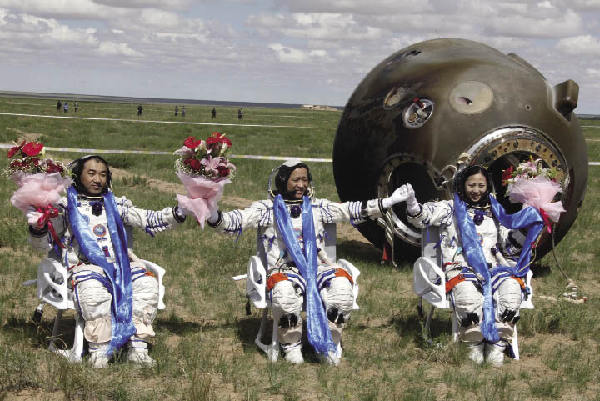China's Fifth Manned Space Exploration
Academician Hu Wenrui of the Chinese Academy of Sciences pointed out that China’s biopharmaceuticals industry is far behind its Western counterpart. However, taking advantage of biological science experiments in space, the industry in China may stand a chance of catching up.
Across the board, many techniques developed for astronauts have already been taken up in civilian fields. For example, the manufacturing of some forms of fast food and synthetic clothing materials is based on technical know-how developed for space.
Young Pioneers
Contributing to the success of the Shenzhou-10 mission was a legion of young scientists and engineers from 110 organizations, and 3,000 support units in nine scientific fields. Mou Yu, 31, was a head electrical designer on the Long March 2F, Shenzhou-10’s carrier rocket. As one of the lead designers of the rocket, Mou, along with his team at the China Academy of Launch Vehicle Technology (CALT), was responsible for dozens of technical innovations that substantially increased systems design reliability. Mou entered the Beijing Institute of Technology in 2000, majoring in aircraft design. Upon graduation with his Ph.D. in 2007, he began working with CALT, home to many young scientists. Those in their 30s, including Mou, number 17,000, accounting for 80 percent of total staff.
Almost as young as Mou from CALT is Liu Ning, aged 33. Liu’s role is also of vital importance to China’s space program: he is a chief designer of the orbiting space lab Tiangong-1. Liu graduated from Tsinghua University’s Department of Mechanics in 2008 with a doctoral degree. He entered the China Academy of Aerospace Science and Technology with glowing recommendations from his tutors at Tsinghua, and joined the Shenzhou program immediately.
With strong encouragement from the government, universities in China in recent years have been fast tracking outstanding young scientists to enter the space program. At present, around 1,000 young men and women are doing master’s or doctoral studies research programs at the China Academy of Aerospace Science and Technology. Those born in the 1980s account for more than 90 percent of the total.
Statistics reveal that of the 150,000 scientists and engineers working in the space industry, 100,000 are 31-33 years old. Yu Menglun, an aerospace mechanics and rocket design expert, said, “The magic of China’s rising so quickly into space is on the back of youth. Well, and the government.”
|
 |
| The Shenzhou-10 capsule lands safely in Inner Mongolia. |
Movin’On Up
Wang Zhaoyao, spokesman for the country’s manned space program, said that the Shenzhou-10 mission marks consecutive successes for the country. With Shenzhou-10’s touching down back on earth, Wang added, China has successfully concluded the “first phase of the second step” of its manned space program.
This “first phase, second step” was approved in February of 2005 and aimed to make technical breakthroughs in astronauts’ extravehicular activities, and in rendezvous and docking technologies.
Previously, the successful launches of Shenzhou-5 and Shenzhou-6 meant the country was ready to launch manned spacecraft and begin conducting application-specific experiments in orbit.
The period from 2005 till now has seen five launches, including Tiangong, Shenzhou-7, Shenzhou-8, Shenzhou-9 and Shenzhou-10. The five launches saw technical breakthroughs in extravehicular activities, automatic and manual docking maneuvers, and target module testing. The technical support system to guarantee astronauts’ safety and work efficiency while in orbit has also been greatly improved.
According to Wang Zhaoyao, China plans to launch its Tiangong-2 space lab around 2015. Its launch will be valuable in gaining experience to build a manned space station. According to design plans, the core unit of the Tiangong-2 space lab, which will be a key section of a future space station, will be launched around 2018. In the run-up to the space station’s being fully operational, a number of automated cargo and manned flights are anticipated. By 2020, China should have, for all intents and purposes, a functioning manned space station.

